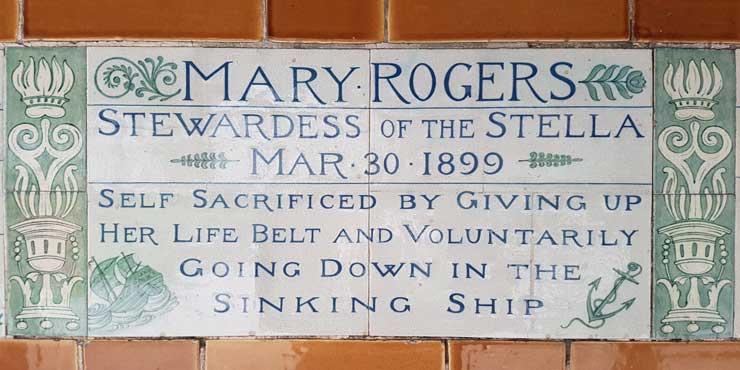
Mary Rogers (1855 - 1899) was one of nineteen crew members who lost their lives in the Stella disaster on Maundy Thursday, March 30th 1889.
By all accounts, many of the crew members, and passengers, demonstrated tremendous courage in the eighteen minutes that elapsed between the ship hitting the Casquets Rocks and actually sinking.
But, it was Mary Rogers, the 46-year-old stewardess, whose story, and heroic act of self sacrifice, captured the pubic imagination.
Her memorial plaque in Postman's Park reads, "Mary Rogers, Stewardess Of The Stella, Mar 30 1899, Self Sacrificed By Giving Up Her Life Belt And Voluntarily Going Down In The Sinking Ship."
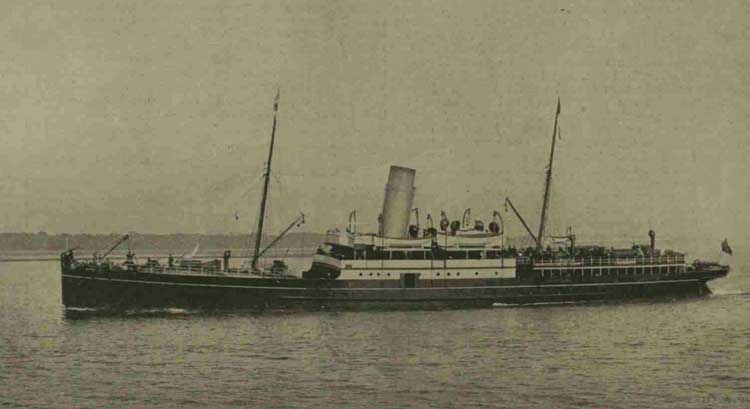
The Stella
From The Illustrated London News 8th April 1899
Copyright, The British Library Board
The Illustrated London News published the following article on the disaster in its issue of 8th April 1899:-
"A very great disaster in the Channel has saddened all who observe with pleasure, at holiday times, the multitudes of people, Londoners and others, availing themselves of railway and steamboat special trips to the pleasant scenes within easy reach of us all.
On Thursday afternoon, the day before Good Friday, in a thick fog between Alderney and Guernsey, the London and South-Western Railway Company's fine steamer Stella, which had left Southampton at a quarter past eleven in the forenoon, was caught among the Casquet rocks, on her way to the islands, and, going at high speed, her steel bottom was torn open in a few minutes on a submerged reef of sharp jagged stone; six boats, with many passengers, all the women and children, were quickly put afloat, and life-belts were supplied; but one large boat was capsized; the ship presently sank, rent asunder by the explosion of her steam-boilers as the sea poured into the engine-rooms; nearly all who had remained on board were drowned."
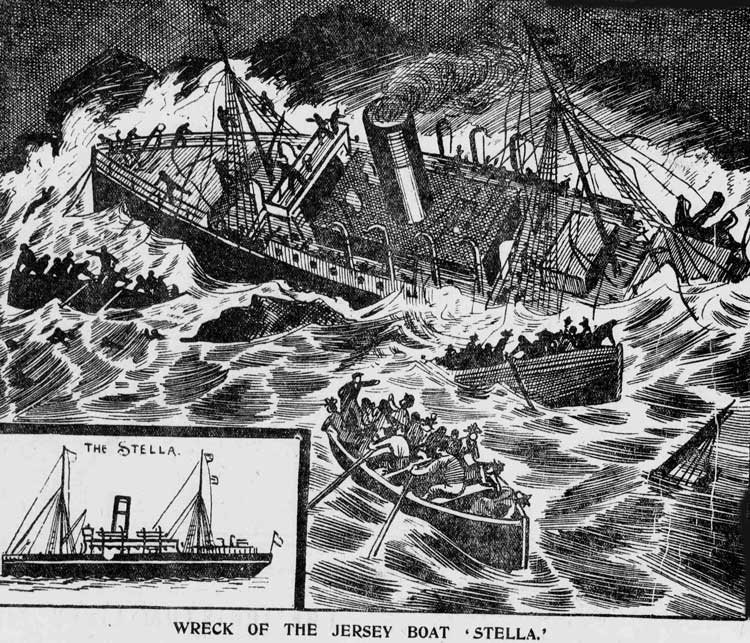
From The Illustrated Police News
8th April 1899
Copyright, The British Library Board
The Illustrated London News article continued:-
Seventy-five lives are lost; 106 were saved.
There were 139 passengers; the ship's officers and crew numbered 42.
The commander, Captain Reeks, the chief engineer, and other officers, with half the crew, perished on board the vessel; Mr. Wade, the chief officer, who was in charge of the boat carrying thirty or forty people, lost his life with them. Mr. J. Reynolds, the second mate, was the only officer who survived.
Seventy passengers, most of them from London, were rescued after drifting about the sea in the boats until half-past six next morning.
The spot where the Stella sank was twenty-three miles from Guernsey, nearly twenty miles from the French coast: the distance from Alderney would, perhaps, be eight miles, but the tide and current were strong against reaching the nearest land.
There was great peril of being swamped; the boats were dangerously overladen, with but two seamen for rowing each boat, assisted indeed by the men passengers.
They were fifteen hours adrift, suffering much from cold, hunger, and thirst, as well as fatigue.
The steamer ought to have arrived at St. Pierre Guernsey, at half-past five in the afternoon; the disaster happened at half-past three.
Early next morning it was made known at Southampton and in London.
Another steamer, the Lynx, of the Great Western Railway Company's Channel Islands service, had picked up a boatload of ladies and other passengers and had taken them to Guernsey.
The Vera, of the South Western Company's line, making her usual daily trip, met with two of the Stella's boats, carrying together fifty-seven people, and brought them on to Jersey.
Several bodies of the dead have been cast ashore on the coast of France."
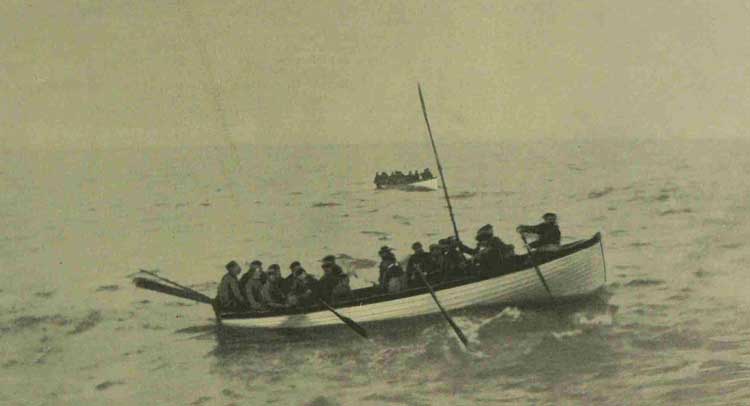
Survivors Hailing The Steamer 6.30 a.m. March 31
From The Illustrated London News 8th April 1899
Copyright, The British Library Board
Within days of the disaster, the newspapers were publishing reports on the courage demonstrated by various members of the crew and, in particular.
On the 12th of April 1899 The Taunton Courier published the following article:-
"The following story was related to one of the officers of the Vera by a gentleman who went to Southampton to interview the family of Mrs. Rogers, the stewardess, who was instrumental in saving the life of a lady friend.
The latter stated that Mrs. Rogers, with great presence of mind, got all the ladies from her cabin to the side of the ship, and after placing lifebelts on as many as were without them she assisted them into the small boats.
Then, turning round, she noticed that the narrator was without a belt, whereupon she insisted upon placing her own belt upon the lady and led her to the fast-filling boat.
The sailors called out "Jump in, Mrs. Rogers," and the latter replied, "No, no; if I get in the boat will sink. Good-bye, goodbye."
With uplifted hands she said "Lord, have me," and immediately the Stella sank beneath her feet."
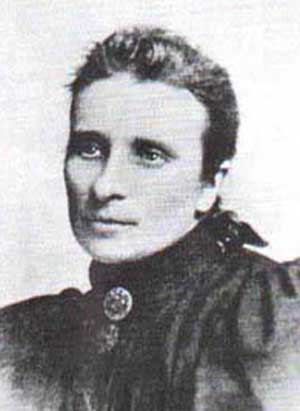
A Portrait of Mary Rogers (1855 - 1899)
Another article, that appeared in the Derby Mercury on the 19th of April 1899 detailed how devoted Mary Rogers had been in pursuance of her duty:-
"Stories of shipwrecks are, unfortunately, too common, but the one bright speck in these mournful scenes is that one or more people generally rise to the occasion, and by their courage and presence of mind are the means of saving life.
The recent awful calamity which befell the South-Western steamer Stella so far resembled other occurrences of the kind that it gave occasion for more than one person to show of what sterling stuff they were made, and certainly the bravery of the stewardess Rogers is not less than that displayed by any other person in any other accident.
She appeared, from all accounts, to regards herself as part and parcel of the ship, nor did she move from her post until all the passengers, the women especially, were supplied with lifebelts, while she persistently refused to accept one for herself, saying that she must stick to the ship..."
It soon transpired that Mary Rogers had left behind an elderly father and two children, all of whom were dependent on her.
By the end of April 1899 Mrs Frances Power Cobbe and Mrs Annie Bryans were spearheading a campaign to erect a memorial to commemorate the sacrifice made by Mary Rogers, and to establish a fund that would support her bereaved dependents.
On the 28th April 1899, the following letter from Mrs. Bryans, was published in the Evening Standard soliciting contributions to the fund:-
"Sir,
I see in The Standard of to-day a short notice of the collection which I am, in conjunction with Miss Frances Power Cobbe and others, promoting to raise a suitable memorial of the heroism of Mary Rogers, the faithful stewardess of the Stella, and to support her aged father and her daughter, who were dependent on her, also to assist her son through his apprenticeship.
Your readers doubtless know that this poor stewardess, having performed her humble duties quietly and faithfully for sixteen years, when the day of peril came, helped to cheer and calm the women and children around her.
She told them there were lifeboats for all, helped them to fasten on their life belts, and, at the last, seeing one lady still unprovided, she insisted in giving up her own, and then refused to risk the lives of others by jumping into the already overcrowded boat.
With uplifted hands, and the prayer, "Lord have me," she calmly faced her end.
We want four hundred pounds at the very least, two hundred pounds to provide for the bereaved father and children, and two hundred pounds to raise a monument worthy of commemorating this humble heroine of the end of the Nineteenth Century.
If enough money is subscribed, we hope that a Home for Sailors' Orphans may be founded. This would, indeed, be a worthy monument of the crowning act of a life lived for others.
Cheques and Post-office Orders (however small) should be sent to me, and crossed Messrs. Martin and Co., bankers, Sidcup.
I am, Sir, your obedient servant,
ANNIE J. BRYANS.
Wollett Hall, North Cray. Kent,
April 26."
The Victorian public showed themselves more than willing to contribute to such a worthy cause and the money began to flood in.
On the 6th May 1899 the Evening Standard published an update on the monies raised:-
"We are requested to state that the Stella Stewardess Memorial Fund, originated by Mrs. A. Bryan, has now reached over £316.
It is proposed to close it at £500, as the Committee think that is enough to continue Mary Rogers work of supporting her aged father and starting her children on useful lives; and also to raise some modest monument to her quietly unselfish life and heroic end."
Ultimately the amount raised was £570 and this was split between the dependents of Mary Rogers and a public memorial that was unveiled in Southampton
The St James's Gazette reported on the ceremony in its edition of Monday 29th July 1901:-
"There has just been unveiled at Southampton a handsome drinking fountain erected as a memorial of the heroic stewardess of the Stella, Mrs Mary Ann Rogers, who was drowned when that steamer struck the Casquets two years ago.
It will be remembered that Mrs. Rogers, seeing a lady passenger without a lifebelt, handed her own and went down with the ship.
The memorial at Southampton was the suggestion of Miss Frances Power Cobbe, and was supported by Mrs. Annie J. Bryans, North Cray, Kent.
The fountain, which is designed in the old Norman Style, has been erected on the Western Esplanade.
The sum of £250, left over from the fund, has been invested with trustees for the benefit of the family of Mrs, Rogers.
The Mayor and Corporation were present, and, despite the heavy rain, a large concourse of spectators witnessed the interesting ceremony."
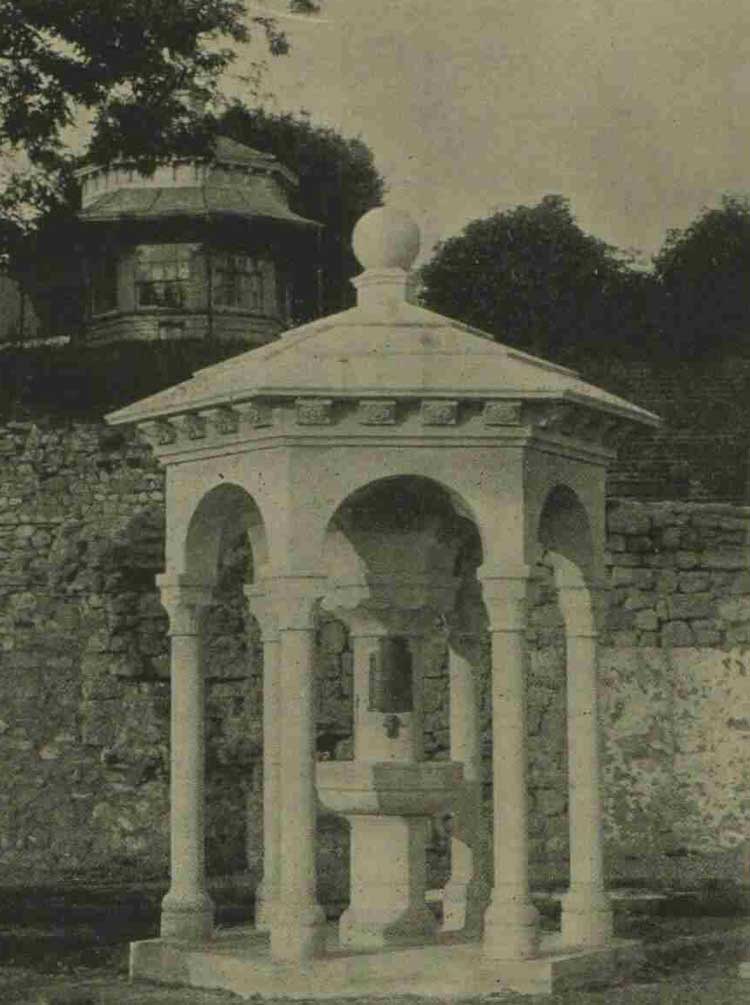
The Mary Rogers Memorial, Southampton.
From The Illustrated London News, 3rd August 1901
Copyright, The British Library Board.
The memorial's inscription, which was composed by Frances Power Cobbe:-
"In Memory of
The Heroic Death
of
MARY ANNE ROGERS
Stewardess of the "Stella"
Who,
Amid the confusion and terror of shipwreck,
Aided all the passengers under her charge
To quit the vessel in safety;
Giving her own lifebelt to one who was
unprotected
Summoned in her turn to make good her escape
She refused;
Lest she might endanger the heavily-laden boat.
Cheering the departing crew
With the friendly cry of " Good-bye! Good-bye!"
She was seen a few months later,
As the " Stella" went down,
Lifting her arms upwards with prayer,
"GOD HAVE ME".
Then sank in the water with the sinking ship
Actions such as these-
Steadfast performance of Duty in the face of death.
Ready self-sacrifice for sake of others
Reliance on God-
Constitute the glorious heritage of our English race.
They deserve perpetual commemoration;
Because
Among the trivial pleasures and sordid strife of
the world
They recall to us for ever
The nobility and love-worthiness of human
nature. "